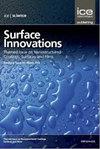单宁酸对彩色Ti/Zr基转化膜成膜过程的影响
IF 3.5
4区 材料科学
Q3 CHEMISTRY, PHYSICAL
引用次数: 0
摘要
铝合金的腐蚀是工业应用中的一个主要问题,引起了安全问题和巨大的经济损失。在过去的几十年里,铬酸盐转化涂层(CCC)在工业中得到了广泛的应用,以相对较低的成本为铝合金提供了卓越的腐蚀保护。然而,禁止使用Cr(VI)的新环境法规引起了人们对CCC替代技术开发的兴趣,但迄今为止,只有钛/锆(Ti/Zr)转化涂层用于工业应用。然而,这些涂层仍存在一些缺点,如外观无色、耐腐蚀性差,影响了其广泛应用。在这里,我们最近开发了一种着色的Ti/Zr基转化涂层,该涂层使用含有C76H52O46(单宁酸,TA)、H2ZrF6、H2TiF6和NaVO3的溶液在AA6063Al合金上形成,能够在室温下快速成膜并提高耐腐蚀性。利用UV-Vis、XPS和IR技术研究了TA对彩色Ti/Zr基转化涂层成膜过程的影响,并探讨了添加TA后可能的反应过程,以及快速成膜和显色的机理。结果表明,TA在转化液老化和成膜过程中与金属离子形成大量的有机配合物是导致涂层快速成膜和显色的主要原因。本文章由计算机程序翻译,如有差异,请以英文原文为准。
Effects of tannic acid on film formation process of colored Ti/Zr-based conversion coatings
Corrosion of aluminum (Al) alloys represents a major issue in industrial applications, giving rise to safety concerns and enormous economic loss. Chromate conversion coatings (CCC) have been widely used in industry over past decades, providing exceptional corrosion protection at relatively low cost for Al alloys. However, new environmental regulations prohibiting the use of Cr(VI) have raised a growing interest in development of the alternative technologies to CCC, but only titanium/zirconium (Ti/Zr) conversion coatings have been used in industrial applications thus far. However, there remain some disadvantages to these coatings, such as colorless appearance and poor corrosion resistance, which affects their wide application. Here, a colored Ti/Zr-based conversion coating, formed on AA6063 Al alloy using a solution containing C76H52O46(tannic acid, TA), H2ZrF6, H2TiF6, and NaVO3, was developed recently by ours, enabling rapid film-formation at room temperature and improved corrosion resistance. The influence of TA on the film-forming process of colored Ti/Zr-based conversion coatings was investigated using UV-Vis, XPS, and IR techniques, and the possible reaction process after adding TA, as well as the mechanism of rapid film formation and color rendering, were also explored. The results showed that, the large number of organic complexes formed by TA with metal ion during the aging process of conversion solution and film formation are the main reasons for the rapid film formation and color rendering of coating.
求助全文
通过发布文献求助,成功后即可免费获取论文全文。
去求助
来源期刊

Surface Innovations
CHEMISTRY, PHYSICALMATERIALS SCIENCE, COAT-MATERIALS SCIENCE, COATINGS & FILMS
CiteScore
5.80
自引率
22.90%
发文量
66
期刊介绍:
The material innovations on surfaces, combined with understanding and manipulation of physics and chemistry of functional surfaces and coatings, have exploded in the past decade at an incredibly rapid pace.
Superhydrophobicity, superhydrophlicity, self-cleaning, self-healing, anti-fouling, anti-bacterial, etc., have become important fundamental topics of surface science research community driven by curiosity of physics, chemistry, and biology of interaction phenomenon at surfaces and their enormous potential in practical applications. Materials having controlled-functionality surfaces and coatings are important to the manufacturing of new products for environmental control, liquid manipulation, nanotechnological advances, biomedical engineering, pharmacy, biotechnology, and many others, and are part of the most promising technological innovations of the twenty-first century.
 求助内容:
求助内容: 应助结果提醒方式:
应助结果提醒方式:


